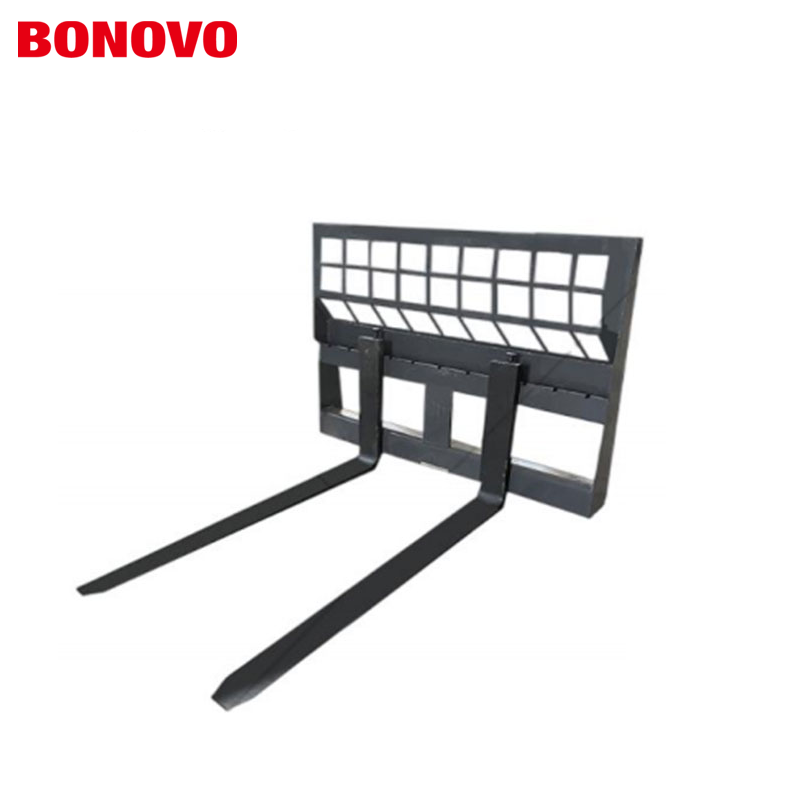In the fields of logistics warehousing, industrial production, etc., forklifts are important material handling equipment, and their forks play a key role. Different operating scenarios and cargo types require different types of forks. Understanding the types and characteristics of forks is of great significance to improving the operating efficiency of forklifts and ensuring operating safety.
I. General-purpose forks
(I) Standard forks
Standard forks are the most common type and are widely used in the handling of various types of conventional goods. They usually have uniform size specifications, with a length generally between 1-2 meters, and the width and thickness vary according to the carrying capacity of the forklift. For example, a forklift with a carrying capacity of 2-3 tons may have a standard fork width of 100-120 mm and a thickness of about 30-40 mm. Standard forks are made of high-quality steel, have good strength and toughness, can meet most daily cargo handling needs, and are the most basic category in the "forklift fork classification".
(II) Adjustable forks
The notable feature of adjustable forks is that the spacing between the forks can be flexibly adjusted according to the size of the goods. This type of fork is equipped with a special adjustment mechanism that can quickly change the distance between the forks manually or electrically. When transporting pallet goods of different specifications, the adjustable fork does not need to be frequently replaced, which greatly improves the operating efficiency. For example, in logistics warehouses, pallets of different sizes often need to be transported, and adjustable forks can easily cope with it, reflecting its "advantage in flexible handling scenarios".
II. Special-purpose forks
(I) Paper roll forks
The paper roll fork is specially designed for transporting paper rolls. Paper rolls are soft and heavy, and ordinary forks are prone to damage the surface of the paper rolls when transporting them. The tines of the paper roll fork are usually wider and curved, which can better fit the surface of the paper roll, disperse the pressure, and prevent the paper roll from being scratched by the fork tines. The length of the tines is also optimized according to the diameter of common paper rolls, generally around 1.5-3 meters, ensuring that the paper roll can be stably lifted, which is a typical representative of the "special fork characteristics".
(II) Brick forks
Brick forks are mainly used in the construction industry to transport bricks, blocks and other goods. Its tines are designed to be sharp and sturdy, making it easy to insert between stacked bricks. In order to adapt to the heavier characteristics of bricks, the overall structure of brick forks is thicker and has a stronger carrying capacity. Some brick forks also have anti-slip devices installed at the ends of the tines to prevent bricks from slipping during transportation, ensuring operational safety and meeting the "special needs of building material transportation".
(III) Barrel clamp forks
Barrel clamp forks are used to transport various types of barreled goods, such as oil barrels, chemical raw material barrels, etc. It can tightly clamp the barrel body through a special clamping mechanism to achieve stable transportation. The clamping force of the barrel clamp fork can be adjusted according to the material and weight of the barrel to avoid damage to the barrel body. This type of fork is widely used in the chemical, food and other industries, solving the "barrel cargo handling problem".
III. Other types of forks
(I) Explosion-proof forks
In some working environments where flammable and explosive items are present, such as refineries and gas stations, explosion-proof forks are required. Explosion-proof forks are made of special explosion-proof materials, which can effectively prevent sparks from collisions during handling and cause safety accidents. Its surface has been specially treated and has good anti-static properties, ensuring safe operation in dangerous environments, reflecting the "application of forks in special environments".
(II) Telescopic forks
Telescopic forks have retractable tines, which can increase the working range of the forks without changing the overall size of the forklift. In some warehouses with small shelf spacing, telescopic forks can easily move goods to the depths of the shelves through the telescopic tines, improving the utilization rate of warehouse space and meeting the "narrow space operation needs".
In short, there are many types of forks, and each type has its own unique design and application scenarios. When choosing a forklift, you need to consider the specific operation requirements, cargo characteristics, and operating environment, and choose the most suitable forklift to give full play to the operating efficiency of the forklift and ensure operational safety.
Choose BONOVO for high-quality, customizable brush cutters for skid steers with fast delivery. Contact us today to discover how our superior products can enhance your land management tasks!

